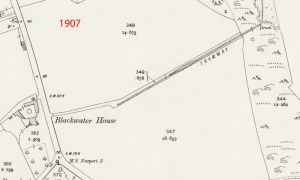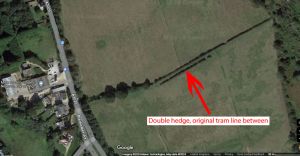St George's Down Tramway, Blackwater
Gravel extraction on St. George’s Down above Blackwater has taken place for many centuries; one problem was always having to use horse carts to move the heavy loads down the roadway to Shide or, in the other direction, Arreton.
In 1886 Frederick Smith Coker[1] laid-down a single track tramway from the pit for about 200 yards down the side of St. George’s Down towards the main road at Blackwater. On this tramway two wagons ran, connected to one another by a steel rope running around a drum at the top, an iron band around the drum regulated the speed at which the wagons moved on the tramway. The wagon at the top would be loaded with gravel, and after the brake was released, it would descend under its own weight, rotating the drum, which would pull up the other, empty wagon. As it was only a single track, before the wagons could pass, the empty one had to be lifted off the rails by a couple of youths.
The wagon, on reaching the lower end, would be emptied and the gravel taken away by horse and cart along the nearby road; some gravel was taken to Blackwater Railway Station from where it was shipped to the other stations around the Island.
The empty wagon then at the top would, in turn, be filled with gravel and the process repeated.
In September 1887, a youth, Walter Dyer, working for Mr. Coker died after an accident on the tramway.[2]
Later a second track was laid so there was no need to lift off the empty wagon when wagons passed.
With the introduction of motor vehicles in the 20th century, the need for the tramway diminished. It not known when the tramway fell into disuse – it was still recorded on the 1939 Ordinance Survey Map.
Satellite images still show evidence of the tramway by a length of parallel hedges which enclosed it.
- ↑ Frederick Smith Coker, Road Contactor, born 1847, Thetford, Norfolk, died 1916, Wiltshire – 1871 census, Carisbrooke - 1891 census, Blackwater
- ↑ Inquest report on Walter George Dyer



